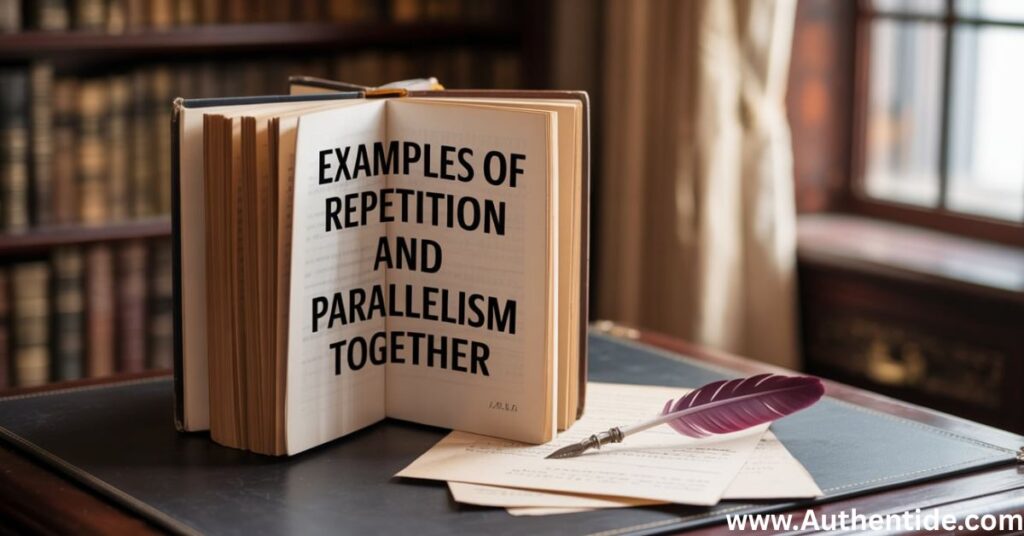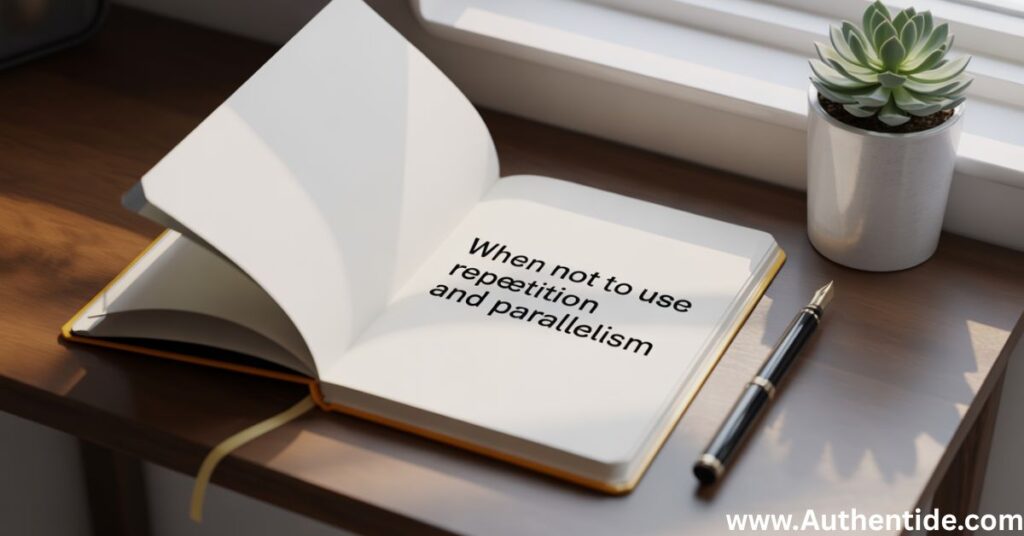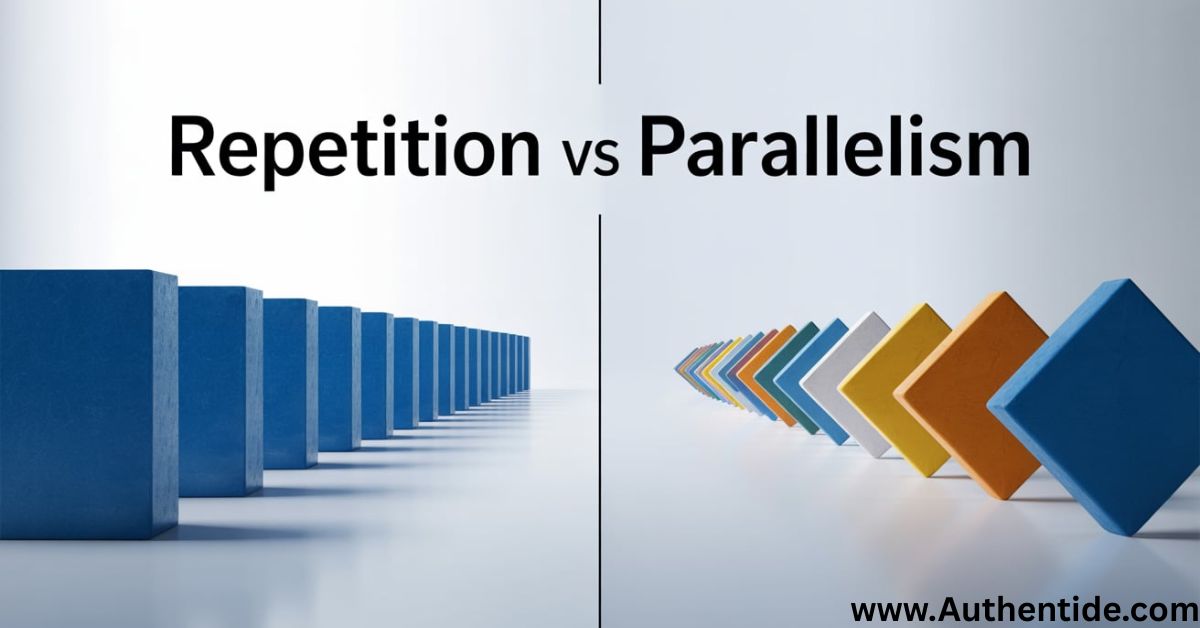Repetition vs Parallelism might sound like a technical debate for grammar nerds, but these two literary devices shape the rhythm, emphasis, and clarity of your writing in powerful ways. Imagine sending an important email where your message lands flat because it lacks the flow or punch it needs. That’s where understanding these tools becomes essential. Whether you’re polishing your professional writing or adding flair to creative content, knowing when to repeat and when to parallel can make all the difference.
To grasp the difference between repetition and parallelism, think of them as siblings: related, but with unique personalities. Repetition in writing is all about emphasizing an idea by using the same words or phrases over and over. It’s bold, deliberate, and hard to ignore. Parallelism in writing, on the other hand, focuses on creating a balanced, rhythmic sentence structure. It doesn’t rely on repetition but uses similar grammatical forms to enhance clarity and impact.
Understanding literary devices like repetition and parallelism gives you more than just grammar bragging rights. It enhances your writing with structure, emotion, and precision. Mastering repetition and parallelism in grammar can elevate your storytelling, sharpen your arguments, and improve your readers’ comprehension. So, let’s dig deeper and discover how you can harness the power of these writing techniques.
What Is Repetition?
Repetition is the intentional reuse of words or phrases to make an idea more memorable or impactful. It’s a rhetorical tool that emphasizes a point and builds emotion.
Example (Email):
“Hi Jackson,We need clarity. We need focus. We need unity. Let’s align our strategy for Q4.”
In this email, the rhetorical repetition of “We need” emphasizes urgency and creates a persuasive tone.
Repetition Examples in Sentences
- “She tried and tried and tried again.”
- “The project was long, the project was exhausting, the project was rewarding.”
- “No, no, no! That’s not what I meant.”
These repetition examples create rhythm and make the text more memorable.
What Is Parallelism?

Parallelism (also known as grammatical parallelism) involves using the same grammatical structure for related ideas within a sentence. It makes writing more organized and easier to read.
Example (Email):
“Hi Sarah,Our team needs to refine the presentation, to reduce the word count, and to rehearse the delivery.”
This is an example of parallel sentence structure, where the repeated “to + verb” form creates a balanced flow.
Parallelism Examples in Sentences
- “She likes cooking, reading, and hiking.”
- “The manager said the proposal was too vague, too long, and too expensive.”
- “He came, he saw, he conquered.”
These parallelism examples illustrate how structure boosts clarity.
Origins of Repetition and Parallelism
Both repetition and parallelism in grammar trace their roots to classical rhetoric. Ancient Greek and Roman orators used these techniques to enhance the power of their speeches.
Origins of Repetition
The use of repetition dates back to Homeric poetry, where phrases were often repeated for rhythm and oral memorization.
Origins of Parallelism
Parallelism in writing has roots in Hebrew poetry, particularly in the Psalms, where ideas are often mirrored using symmetrical sentence structure.
The Key Differences Between Repetition and Parallelism
Here’s a quick breakdown of the difference between repetition and parallelism:
| Feature | Repetition | Parallelism |
|---|---|---|
| Focus | Repeated words/phrases | Balanced structure |
| Effect | Emphasis, emotion | Clarity, flow |
| Common Use | Speeches, persuasive writing | Academic, business, and technical writing |
So, when it comes to repetition vs parallelism, choose repetition when you want to stress a point and parallelism when you want to keep things smooth and orderly.
Is Parallel Structure the Same as Repetition?
No. While both involve patterns, parallel structure relies on consistent grammatical form, not repeated words.
Not Parallel: “She likes dancing, to cook, and reading.”
Parallel: “She likes dancing, cooking, and reading.”
Using Repetition and Parallelism in Sentences
Using Repetition
- Reinforce key points
- Build emotional rhythm
- Create catchy slogans
Example (Motivational Speech): “Don’t stop when you’re tired. Don’t stop when you’re defeated. Don’t stop at all.”
Using Parallelism
- Improve readability
- Maintain consistency in lists
- Elevate formal writing
Example (Project Update Email): “The team met the deadline, exceeded the quality expectations, and stayed within budget.”
Examples of Repetition and Parallelism Together

Sometimes, these devices work best when paired.
Example:
“We want justice, we want peace, we want change.”
This sentence blends repetition (“we want”) with parallelism (noun forms: justice, peace, change).
Common Mistakes to Avoid
- Using repetition without purpose makes writing feel redundant.
- Misusing parallelism can cause confusion or awkward phrasing.
Wrong: “He is responsible for writing the report, attending meetings, and his emails.”
Right: “He is responsible for writing the report, attending meetings, and responding to emails.”
Pro Tips for Mastering Repetition and Parallelism
Here’s how to elevate your writing:
- Balance emotion and clarity. Use repetition for emotional emphasis; use parallelism for structural flow.
- Read aloud. Sentences with strong rhythm stand out.
- Use tools like Grammarly to catch awkward constructions.
- Aim for variety. Don’t overuse either device—mix in other stylistic devices in English for dynamic prose.
- The rule of three in writing is a powerful technique: repeat or parallel three ideas for maximum impact.
Context Matters
Different situations call for different techniques.
- In creative writing, repetition can create tension or a poetic effect.
- In business writing, parallelism keeps your message crisp and professional.
When Not to Use Repetition and Parallelism

Avoid overusing either technique:
- Don’t repeat ideas that are already clear.
- Don’t force parallelism where it feels unnatural.
- Use them where they enhance, not distract from, your core message.
Conclusion
When comparing repetition vs parallelism, it’s clear that both are essential tools in a writer’s toolkit. While repetition delivers impact through emphasis, parallelism enhances clarity through balance. Knowing the difference between repetition and parallelism allows you to use them thoughtfully and effectively in everything from persuasive emails to compelling poetry.
Whether you’re focused on improving clarity in writing, refining your syntax and style, or just adding flair to your sentences, mastering these devices ensures your message is heard—and remembered.

Your go-to place for smart synonyms and celebrity updates. Muhammad Hassan Abid is dedicated to creating useful, engaging content that informs, inspires, and truly serves your curiosity

